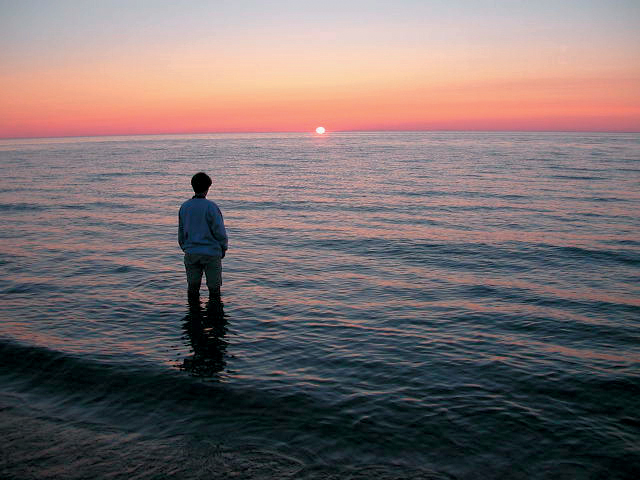From our 2007 Annual Report
Spring is now in full bloom. On this beautiful, if blustery day, a kingfisher swoops out over the shallow waters of the tiny lake where I’ve come to watch birds and maybe fish for a little while.
From my vantage point I can see, over the lake in the distance, the flank of a large sand dune where, some 38 years ago, I sat down on a similarly blustery day, to write my first college geology paper. I chose to try to figure out, without painstaking research, how this expanse of sand managed to collect on the brow of a bluff 300 feet above Lake Michigan. Then as now, I still try to ask and answer such questions about Leelanau County and its landscapes.
Back in 1968, the dune formation I pondered is now part of the National Lakeshore. A trailhead leads to the top of my dune, and it would be a rare day to not see people enjoying the view, looking out over the Manitou Islands. That so many have the opportunity to enjoy, experience, and try to understand the landscape of this beautiful peninsula is a gift.
Having long ago learned the actual explanation of how this particular dune formed, my thoughts today drift to how and why – after these many years – Leelanau County still strikes me as one of the most precious landscapes in the world. My experience has shown me that it is possible to live in, and to attentively study the same small place decade after decade. The Leelanau peninsula ceaselessly evades and exceeds my comprehension.
My fascination with this corner of the world is far from unique. But having the good fortune to work for the Leelanau Conservancy has afforded ample opportunities to observe how people interact with this place. Why are some people willing to significantly alter their lives and plans to live here, and to try to fit in with the local culture and the landscape? Others come, may live here, but never seem to be quite as captivated. The first group believes Leelanau to be a uniquely beautiful place deserving special efforts and careful stewardship. A second group, while agreeing that this may be a scenic corner of the Midwest, seems resigned to the idea that no place, however beautiful, can or should be exempted from the laws of economics and the march of time.
But this difference in attitude goes deeper I think. Aldo Leopold, in his famous essay “The Land Ethic,” identified a “cleavage” among conservationists between those who “(A) Regard the land as soil, and its functions as commodity production; another group (B) regard the land as biota, and its function as something broader.” Leopold identifies the “key log” which must be moved to build a broader land ethic as “simply this: quit thinking about decent land use as solely an economic problem. Examine each question in terms of what is ethically and aesthetically right, as well as what is economically expedient.”
To a large extent Americans have always regarded land as a commodity. In this view land is a means to an end, not an end in itself. Many people tend to value land, including Leelanau County, for its economic capacity – not just the ability to grow timber or cherries – but increasingly as a collection of view lots for condominiums, as home sites real or potential. There are even people, backed by huge corporate interests, which regard much of Leelanau as a perfect platform on which to erect giant wind turbines. The turbines, each of which would exceed the height of the Statue of Liberty by more that 100 feet, are designed to commoditize the very wind that blows.
Those people who regard Leelanau County as a special and unique landscape seem to take every opportunity to adapt to the culture and climate of the place. Wendell Berry, in his essay “Life Is a Miracle” extols the benefits of a locally adapted culture, and laments its loss in much of America. Wendell writes that the locally adapted culture “over a long time learns to conform its artifacts to the local landscape, local circumstances, and local needs. This is exactly the opposite to the way of industrialism, which forces the locality to conform to its artifacts, always with the most dreadful consequences to the locality.”
Leelanau has changed greatly since 1968. No one argues that this peninsula should be frozen in time, an agrarian idyll from the mid-20th century. But many of us, evidenced by over 2,600 members of the Leelanau Conservancy and countless others, would likely suggest that this landscape does have qualities that truly are unique – dare I say “sacred”- and that a place of such beauty deserves extra effort when it comes to the way we use the land. This group seems to have internalized Aldo Leopold’s fabled “land ethic.” This group is willing to consider public investments in preserving farmland, thinks that new developments should be of a size and scale in keeping with the local vernacular, and in general wants to amend the view that holds land as a commodity. The “land ethic” group is not composed solely of retirees or conservationists – it includes builders, architects, and developers who are willing to take extra care in the way that they meet the needs of their clients while also considering the landscape.
There will be many challenges ahead, not only condominium developments but now wind farms as well. But perhaps the biggest challenge will be to maintain a sense that Leelanau is unique, is uniquely beautiful, and has a bright economic future if we continue to think of this peninsula in its entirety, and as a biotic community, not as a commodity.




